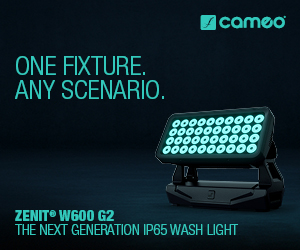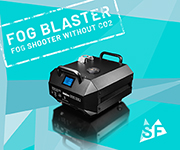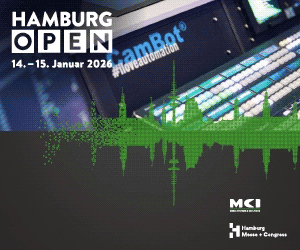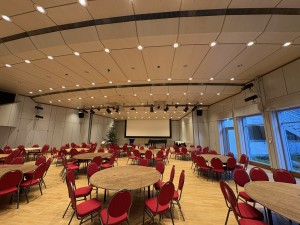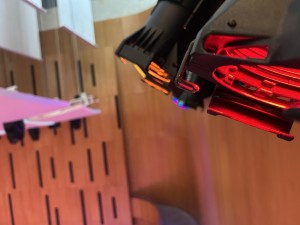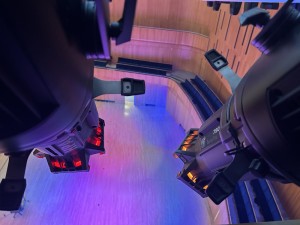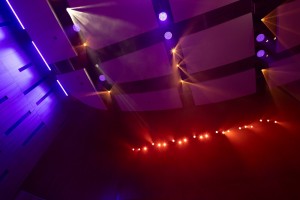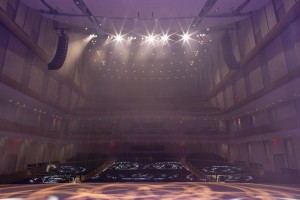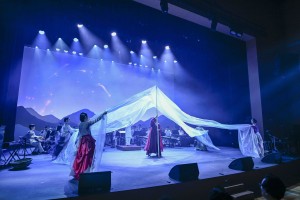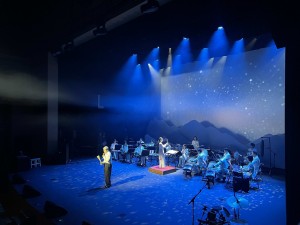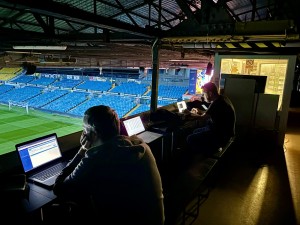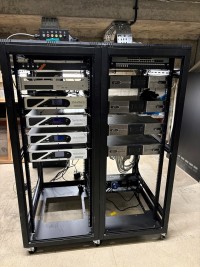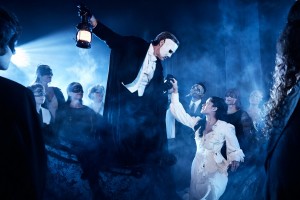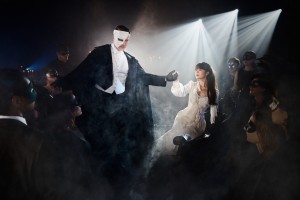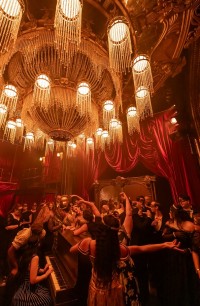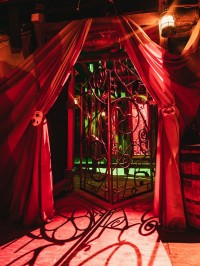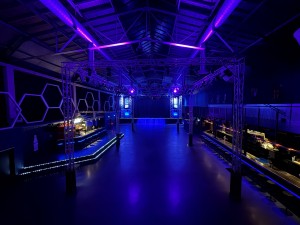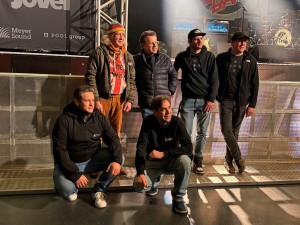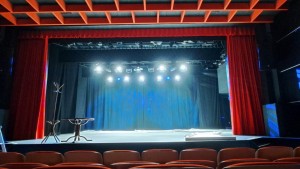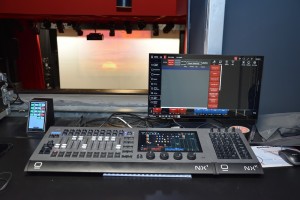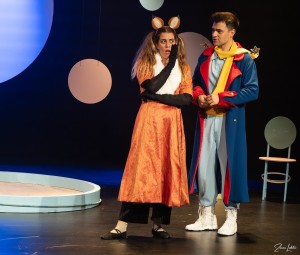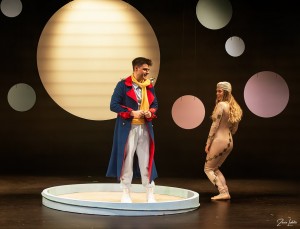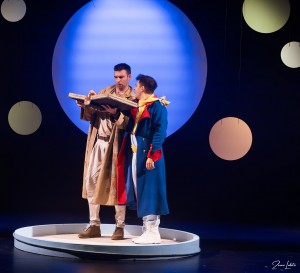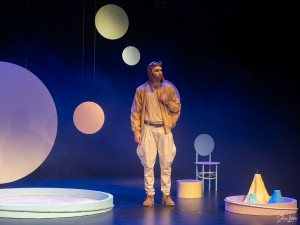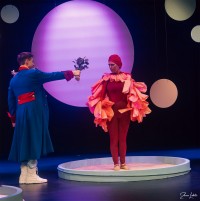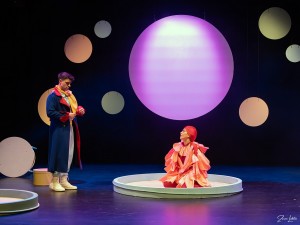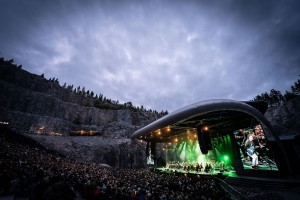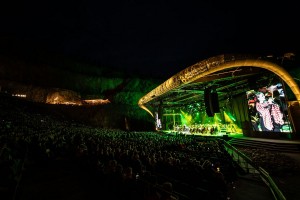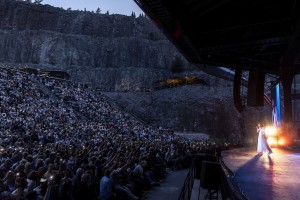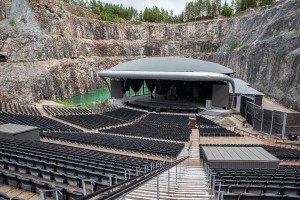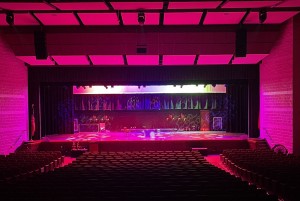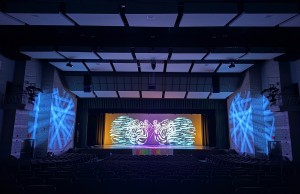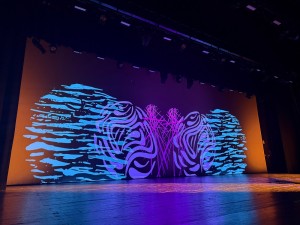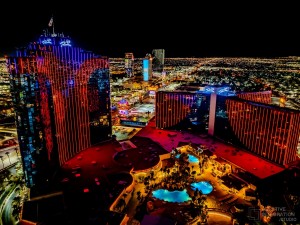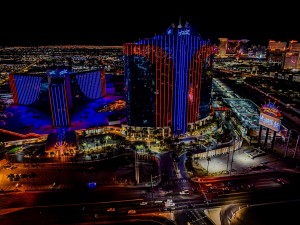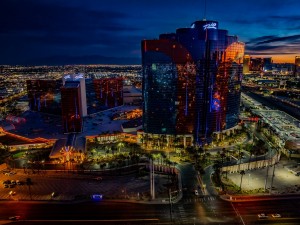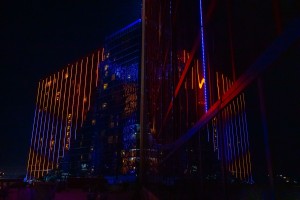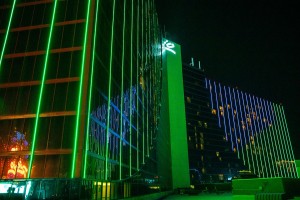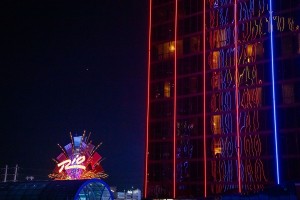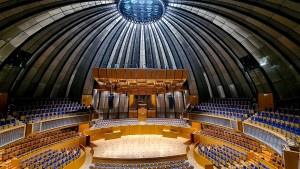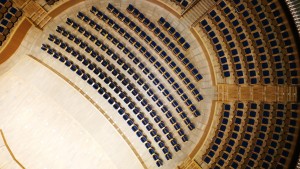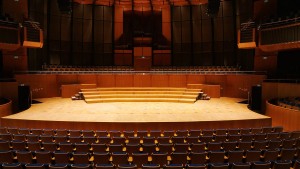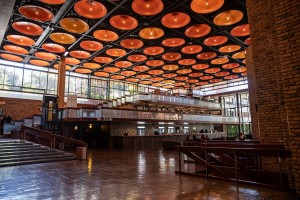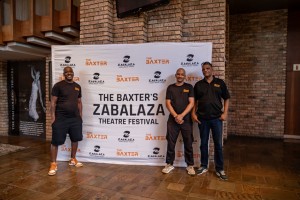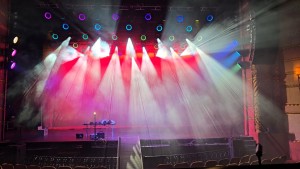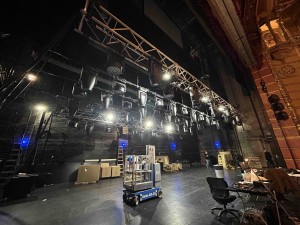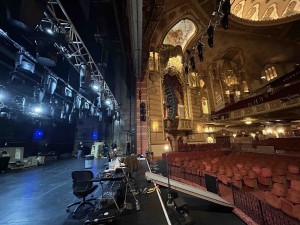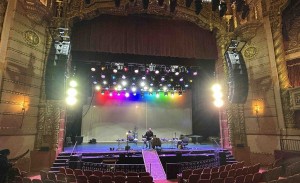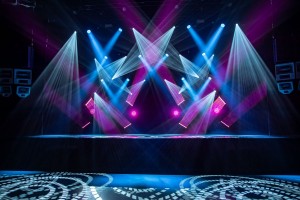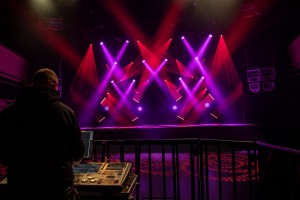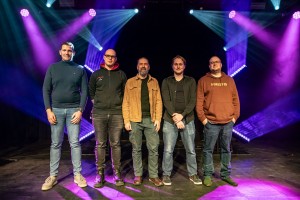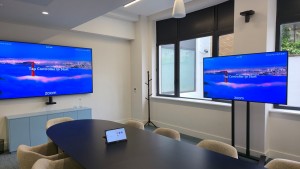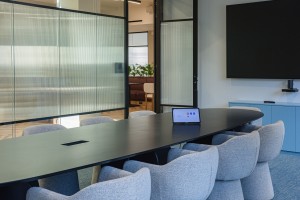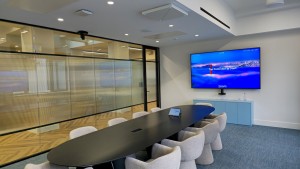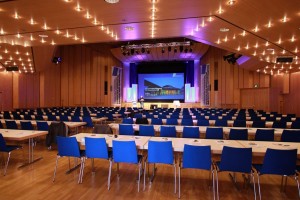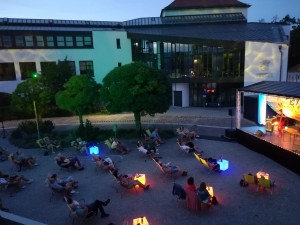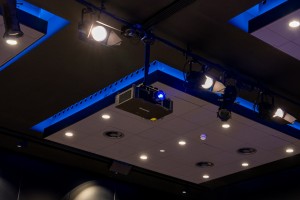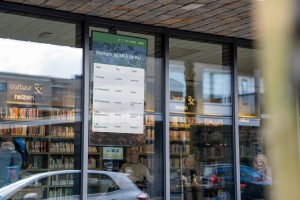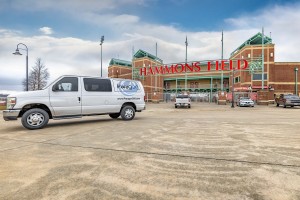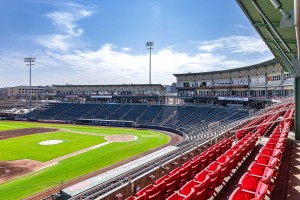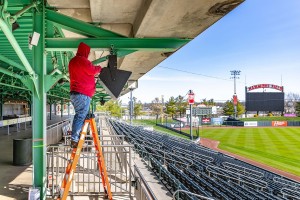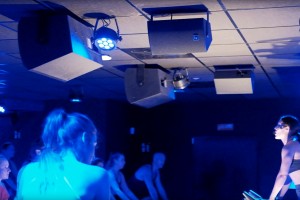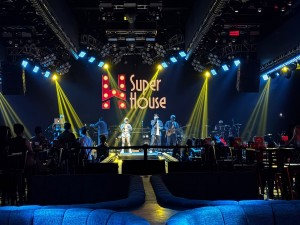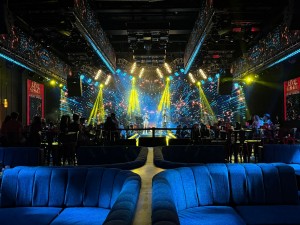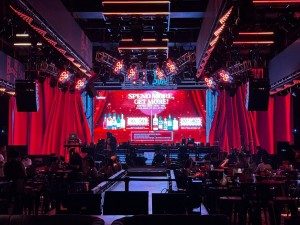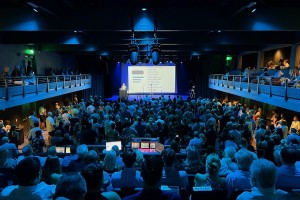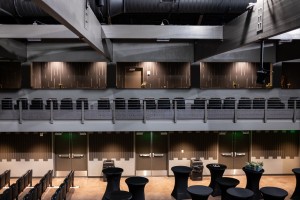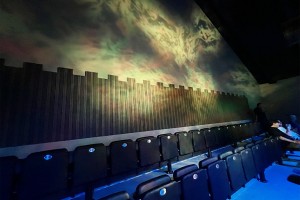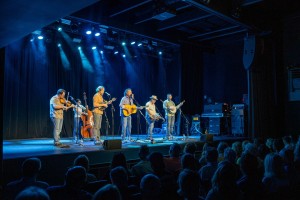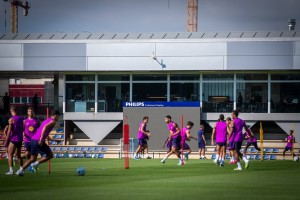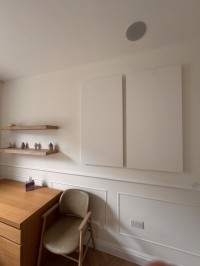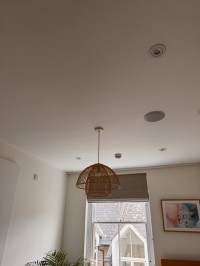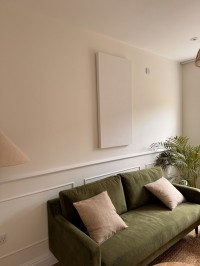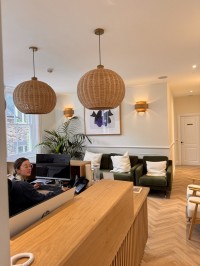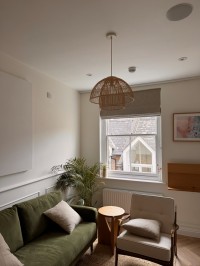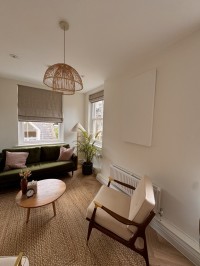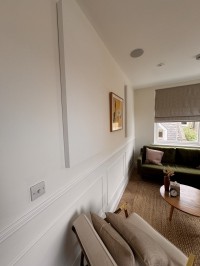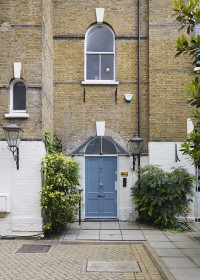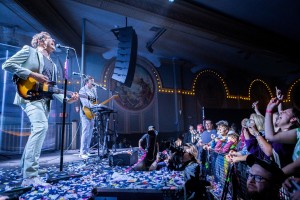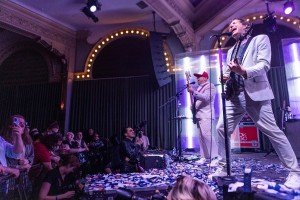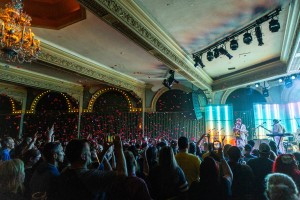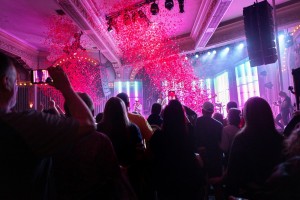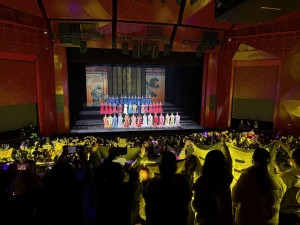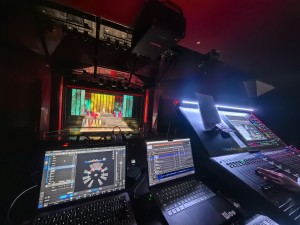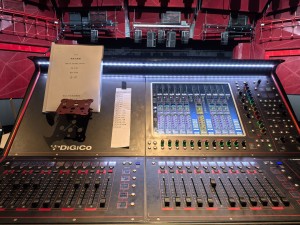Installationen News
Installationen News Schlagzeilen
Namwon Arts Center chooses Ayrton Argo 6 FX
24/11/2025
Avolites media server selected for new lighting installation at Rio Hotel & Casino Las Vegas
03/10/2025
Neushoorn upgrades with Robe
12/09/2025
Neue Beleuchtung im Minnesängersaal des „Palatin“ Wiesloch
Im „Palatin“, einem Kongresshotel und Kulturzentrum in Wiesloch im Rhein-Neckar-Kreis, finden unter anderem Kongresse, Tagungen, Konzerte, Theateraufführungen und Ausstellungen statt. Nach einer Erneuerung der Saalbeleuchtung im größeren Staufersaal im Jahr 2023 wurde jetzt auch im zweitgrößten Saal des Hauses die Beleuchtung in Zusammenarbeit mit Feiner Lichttechnik erneuert.
Der Minnesängersaal im „Palatin“ trägt den Namen des mittelalter-lichen Minnesängers Heinrich I. Swendinger von Wissenloch und verbindet musikalisches Erbe mit moderner Veranstaltungsarchitektur. Der Saal bietet mit einer Gesamtfläche von 280 Quadratmetern und einer Deckenhöhe von bis zu 5,4 Metern Raum für unterschiedlichste Veranstaltungsformate.
Wie im Staufersaal wurden auch im Minnesängersaal Talus FX Downlights von Electron (100 Stück) in der 37-W-Version mit warmweißer 2.700-K-Farbtemperatur und einem Farbwiedergabeindex von CRI 90 installiert. Ziele der Erneuerung waren auch in diesem Saal neben der Energie-Einsparung eine verbesserte Lichtqualität sowie eine höhere Lichtstärke.
Als LED-Treiber werden 25 vierkanalige FBox 4CC-AN-TS von Feiner Lichttechnik verwendet, die zentral in einer Unterverteilung montiert wurden. Die Ansteuerung der Downlights erfolgt per DMX mit 16 bit und damit dem gewünschten Dimmverhalten für den Veranstaltungsbetrieb. Durch die Amplitudendimmertechnik der FBox-Treiber arbeitet die Regelung flickerfrei und kameratauglich.
Darüber hinaus kommen im Minnesängersaal dreizehn Puls-Netzteile, ein Proplex-DMX-Splitter und ein Proplex-IQ-Two-88-Node zum Einsatz.
(Foto: Feiner Lichttechnik/„Palatin“ Wiesloch)
TMS installs Elation KL Core at Holland Performing Arts Center in Omaha
Theatrical Media Services (TMS) recently completed a major lighting retrofit at the Peter Kiewit Concert Hall in Omaha, Nebraska’s Holland Performing Arts Center, selecting Elation’s KL Core IP LED light engine as the backbone of the venue’s new front and side lighting systems.
The Holland Center, home of the Omaha Symphony Orchestra, is among the nation’s premier performing arts venues. The 2,000-seat “shoebox” style hall, with its open design and maple interior, was purpose-built twenty years ago as a state-of-the-art acoustic space and hosts events five days a week during its busy season, ranging from symphony performances to touring acts, comedy, and rock shows. Over time, however, its original lighting system, a mix of standard ellipsoidals and early model LEDs, had past its prime.
TMS designed and supplied the new lighting system and supporting infrastructure. With help from Elation regional rep William Irwin, they organized a demo and shootout that led to selecting the KL Core IP as the optimal choice. The KL Core IP features a 400 W RGBMA LED engine and can be adapted as an ellipsoidal, Fresnel, or monolight. Its compatibility with third-party shutter barrels allowed TMS to repurpose barrel mounts from the venue’s existing Source Four fixtures and attach them to the KL Cores.
“That’s one of the reasons we were able to sell the Core specifically to this space”, says Michael Arch, Vice President of Production at TMS. “It allowed them the flexibility to use their existing inventory of barrels but added in the flexibility you get from a great color engine.” Arch spent nearly four years at the Holland Center as the house electrician and lighting designer before he and his partners purchased TMS last January.
“One of the challenges we faced with the previous lighting rig was that it used undersized profile fixtures and relied on conventional lighting, which wasn’t always conducive to focusing”, he continues. “I had been advocating for some time to bring in moving lights and upgrade to a new generation of LED fixtures in the front and side positions, where we ultimately installed all of the KL Core units.”
The KL Core IP’s light source offers a CRI of 94.9 and 16-bit CCT control from 2,400 K to 8,500 K, providing precise color consistency and tunable white light. The orchestra requires high lighting positions, and at the Holland Center, where the FOH position is 80’ away, each fixture’s 15,000-lumen output ensures bright, even coverage across the large stage.
The new system includes 76 KL Core IP fixtures (72 active), with 5° and 10° barrels for front light and 19° and 26° barrels for side positions. The KL Cores form the backbone of the front and side lighting systems, complementing the new LED moving heads overhead.
During the Covid pandemic, the Omaha Symphony expanded its video capabilities to engage audiences who could not attend a performance in person. That shift, says Arch, made high-CRI, camera-friendly lighting a top priority. “I had a fixture overhead running at 7,200 K and conventional fixtures out front at 3,200 K, so we had different color temperatures competing on camera”, he explains. “There was a real intention to get fixtures with very high CRI to ensure that everything looked correct when filming in the space.”
Replacing 750 W conventional lamps with 400 W LEDs has also delivered significant energy and maintenance savings. “Not having to replace lamps or gels, combined with the energy efficiency of the Cores, has been noticeable”, states Arch. The fixture’s IP65 rating also means that dust and other particulates are kept out of the fixture, helping to protect internal components and requiring less frequent maintenance.
The new lighting system debuted in September 2025, just in time for The Holland Performing Arts Center’s 20th Anniversary celebration on October 3, which featured the Omaha Symphony and local artists.
(Photos: Sarah Lemke/Bill Sitzmann/TMS)
Namwon Arts Center chooses Ayrton Argo 6 FX
South Korea’s Namwon Arts Center has invested in twenty-four Ayrton Argo 6 FX fixtures. “This may have been the first time I have used Ayrton fixtures but the reasons were very clear to me”, explains Jae Beak Im, Namwon Arts Center’s Lighting Director. “As a group, we took a trip to Hansam System in Seoul back in March to look at and compare lights from several different manufacturers. The Ayrton Argo 6 FX won for many reasons: the compact size, brightness of the light source, quiet operation, and the effective delivery of its features.”
The team who accompanied Jae Beak Im comprised six staff from the City Hall and a number of theatre experts to ensure all aspects of the purchase choice were covered. The venue itself is a relatively small, intimate space with just over three hundred seats and a stage some twenty by fifteen metres in size with a thirteen and a half metre ceiling height. In addition, the fixtures needed to be flexible enough to work in various other cultural spaces in the Center that are also used for educational and youth group presentations.
“Argo 6 FX has a vast array of features”, continues Jae Beak Im. “For me and what I wanted to achieve, the most impressive are Liquid Effect and Infinite Rotation.” Ho Seong Son from the technical team adds: “The versatility of Argo 6 FX enables us to cover all theatre, concerts, exhibitions and corporate events, and it reduces long-term maintenance costs. Also, the IP65 rating should not be overlooked - as an arts centre, the ability to use our outdoor spaces with confidence is very important to us.” Hansam System, Ayrton’s exclusive distributor for South Korea, supplied the twenty-four Argo 6 FX fixtures to Namwon Arts Center.
(Photos: Namwon Arts Center)
Peavey-Audiodesign in Elland Road Stadium installiert
Der Leeds United Football Club hat sich mit Peavey Commercial Audio zusammengetan, um in seinem Elland Road Stadium ein vollständig integriertes Audiosystem zu installieren. Das vorherige Audiosystem des 40.000 Zuschauer fassenden Stadions hatte dem Verein zwar lange Zeit gute Dienste geleistet, aber mit steigenden betrieblichen Anforderungen zunehmend Alterserscheinungen gezeigt.
Der Spielbetrieb erforderte eine Lösung, die mehrere Funktionen - von Notfalldurchsagen und allgemeinen Ankündigungen bis hin zu Hintergrundmusik und Rundfunkübertragungen - in einer einzigen, zusammenhängenden Infrastruktur vereinen konnte. In Zusammenarbeit mit dem Verein entwickelte Peavey eine vernetzte Audioinfrastruktur, die verteilte DSP-Verarbeitung, zentralisierte Überwachung und vollständige Redundanz kombiniert.
Der Verein benötigte vollständige Transparenz und Kontrolle über alle kritischen Komponenten des Systems, einschließlich Verstärkern, DSPs und Fire-Mikrofonen, um sicherzustellen, dass jedes Problem sofort erkannt und behoben werden kann. Angesichts zehntausender Fans und strenger Sicherheitsvorschriften muss das System unter allen Umständen voll funktionsfähig bleiben, selbst im Falle eines Netzwerkfehlers.
Peavey entwarf und lieferte eine verteilte MediaMatrix-Nion-DSP- und zentralisierte Steuerungsarchitektur, die über ein redundantes Glasfaserring- und 1-Gb-Kupfernetzwerk bereitgestellt wurde. Das Design wurde so konzipiert, dass es betriebliche Flexibilität und zukünftige Skalierbarkeit bietet.
Das Herzstück der Installation sind zwei Peavey nCIE-Pilot-Prozessoren. Diese Geräte überwachen kontinuierlich den Status jedes angeschlossenen Geräts und liefern sofortige Warnmeldungen und Systemzustandsberichte. Außerdem verwalten sie die Sprachalarmsteuerungsanzeige für externe Geräte und gewährleisten so unter allen Betriebsbedingungen sicherheitskritische Funktionen.
Das Audio-Routing und die Matrixierung werden von zwei Nion-DSP-Prozessoren übernommen, die jeweils mit identischen Ein- und Ausgängen konfiguriert sind, um alle Eingangsquellen - Notfall-Paging, allgemeines Paging, BGM und LUTV-Feeds - aufzunehmen. Der Ton wird über ein Dante-Netzwerk an eine Reihe von Powersoft-Verstärkern verteilt, die mehrere miteinander verbundene Lautsprecherzonen sowohl im Hauptbereich als auch im Back-of-House-Bereich versorgen. Jedes DSP-„Edge“-System ist für den Standalone-Betrieb ausgelegt. Sollte ein Netzwerkfehler auftreten, arbeiten die lokalen Einheiten unabhängig voneinander weiter und stellen so sicher, dass Notfall-„All Call“-Meldungen im gesamten Stadion aktiv bleiben.
Zwei MediaMatrix-Nion-N3-Dante-DSPs befinden sich nun in der Westtribüne, vier weitere sind in der Osttribüne installiert. Dazu kommt ein MediaMatrix-nCIE-Pilot-Überwachungsserver. Das LUTV-Produktionsstudio beherbergt außerdem eine MediaMatrix-sDAB-16i-Netzwerk-Audiobrücke. Über am Dach angebrachte Mikrofone, die je nach Belegung der Räume ein- und ausgeschaltet werden können, ist es möglich, die Geräusche der Zuschauer in bestimmte Bereiche des Stadions zu übertragen.
(Fotos: Peavey Commercial Audio)
LD Systems ermöglicht immersive Audioinstallation für Broadway-Musical „Masquerade“
Seit Ende Juli 2025 wird in New York das neue Musical „Masquerade“, eine Neuinterpretation von Andrew Lloyd Webbers „The Phantom of the Opera“, aufgeführt. Das immersive Konzept der Produktion unter der Regie von Tony-Award-Gewinnerin Diane Paulus sprengt dabei klassische Theatergrenzen: Anstelle fester Sitzplätze bewegen sich die Gäste frei durch ein mehrstöckiges Gebäude in Midtown Manhattan und sind mittendrin im Geschehen.
Die besondere Raumarchitektur und der ständige Wechsel der Publikumspositionen stellten besondere Anforderungen an die Beschallung, für die Sounddesigner Brett Jarvis verantwortlich zeichnet - gelöst durch die bislang umfangreichste LD-Systems-Audio-Installation weltweit.
Das frühere Kaufhaus „Lee’s Art Shop“ auf der 57th Street wurde für die Produktion komplett umgebaut. Jede Etage präsentiert eigene Schauplätze - von opulenten Ballsälen bis zu geheimnisvollen Katakomben. Schauspiel, Musik, Tanz und detailreiche Raumgestaltung verschmelzen zu einer Inszenierung, die das Publikum hautnah und aus ständig wechselnden Perspektiven erlebt.
Die Anforderungen an das Audio- und Beschallungssystem: gleichmäßige Schallverteilung über mehrere, sehr unterschiedlich gestaltete Räume, maximale Sprachverständlichkeit in jedem Winkel, minimierte Rückkopplungsanfälligkeit bei Headsets und Lavaliermikrofonen, natürliche Hochtonwiedergabe für klassische Arrangements, kraftvolle Tieftonwiedergabe für Orgeltöne - all dies eingebettet in eine immersive Klanggestaltung. Zusätzlich mussten die Lautsprecher so unauffällig in die Szenerie integriert werden, dass sie die Immersion nicht stören.
„Schon im ersten Gespräch mit Sounddesigner Brett Jarvis und dem Andrew-Lloyd-Webber-Produzenten Lee McCutcheon wurde klar, dass wir für ‘Masquerade’ alle Register ziehen müssen“, sagt Jens Kleinhuis, Field Application Engineer Pro Audio der Adam Hall Group. Gemeinsam mit Ivan Klepac, Field Application Engineer Integrated Systems aus dem Integrated-Systems-Projekt-Support-Team, entstand im Laufe mehrerer Demotermine und Training-Angebote ein Audiosetup mit über 1.000 Lautsprechern, davon allein rund 660 Curv-500-Satelliten, 186 Dqor- und über achtzig Maila-Array-Systeme.
Neben den Maila-, Dqor- und Curv-500-Systemen nutzten die „Masquerade“-Produzenten auch Maui-i1-Zeilenlautsprecher, CFL-Deckeneinbausysteme und die neuen Icoa-Pro-Sub-21-A-Subwoofer aus dem LD-Systems-Portfolio. Zudem kommt ein Pärchen Anny-8-Bluetooth-PA-Lautsprecher zum Einsatz. Angetrieben und gesteuert wird das komplette System von 68 IPA-424-T-Vierkanal-Installationsendstufen, die jeweils mit einer X-EDAI-Ethernet- und Dante-Erweiterungskarte ausgestattet wurden, um alle Komponenten in das vorhandene Dante-Netzwerk zu integrieren.
„Die Zusammenarbeit mit Brett Jarvis und dem gesamten ‘Masquerade’-Team war inspirierend und partnerschaftlich auf höchstem Niveau“, sagt Gabriel Medrano, President/COO Adam Hall North America. „Der Einsatz von Maila in diesem einzigartigen Umfeld markiert einen echten Meilenstein in der Geschichte von LD Systems - technisch, kreativ und emotional.“
(Fotos: Matthew Murphy/Oscar Ouk/Luis Suarez/Suarfotos LLC/Evan Zimmerman)
Jovel Music Hall mit Meyer Sound Panther und Ultra-X80 ausgestattet
Die Jovel Music Hall in Münster nutzt ab sofort als erster Club in Deutschland sowohl ein Panther-Line-Array- als auch ein Ultra-X80-System. Beide Systeme von Meyer Sound wurden im Rahmen eines umfassenden Upgrades der Beschallungssysteme in der 1979 von Steffi Stephan (Bassist und langjähriger musikalischer Weggefährte Udo Lindenbergs) gegründeten Halle installiert.
Bereits seit 2012 vertrauen sowohl das Jovel als auch sein betreuender Event-Partner, die Poolgroup GmbH, auf Meyer-Sound-Beschallungslösungen. In der Konzerthalle des Clubs, der Music Hall, sorgte viele Jahre lang ein Milo-System in Kombination mit 700-HP-Subwoofern für den Sound. Mit der kontinuierlichen Weiterentwicklung der Meyer-Sound-Systeme stand nun auch hier ein Upgrade an.
Installiert wurden je fünf Panther-L und ein Panther-W pro Seite, ergänzt um sechs 2100-Low-Frequency-Control-Elemente im Cardioid-Setup. Vier Ultra-X40-Point-Source-Lautsprecher runden das System als Nearfills ab. Das gesamte System ist über ein Milan-AVB-Netzwerk miteinander verbunden und wird über eine Galileo-Galaxy-816-Netzwerkplattform gesteuert.
Parallel zum Upgrade in der Music Hall wurde auch der Jovel Club mit Meyer-Sound-Beschallungslösungen der aktuellen Generation ausgestattet: Hier sind ab sofort zwei Ultra-X80 und zwei Ultra-X23 als Nearfills sowie vier bereits vorhandene 700-HP-Subwoofer im Einsatz.
Foto (v.l.): Kevin Berlauwt, Sales Manager, Meyer Sound; Steffi Stephan, Geschäftsführer, Jovel Music Hall; Carl Cordier, Geschäftsführender Gesellschafter, Poolgroup GmbH; Marvin Lindenberg, Geschäftsführer, Jovel Music Hall; Jan Flerlage und Marvin Wolf, Projektleitung, Poolgroup GmbH. (Fotocredits: Eurocityfest GmbH/Poolgroup GmbH)
AVC and Elation revive Croatia’s Kazaliste 21
Kazaliste 21 (Theater 21) in Sisak, Croatia, has reopened its doors with an Elation lighting system by Audio Video Consulting (AVC), marking a major milestone in the theater’s post-earthquake recovery. The 6.4 magnitude earthquake that struck the region on December 29, 2020, caused significant damage to the venue, temporarily silencing a key hub of local arts and culture.
The newly renovated theater is a modern performance venue, hosting theater, music, and puppet productions, operated by Dom kulture Kristalna kocka vedrine - City Theatre Sisak. At the heart of the 200-seat theater is a new Elation lighting rig and Obsidian control solution, designed and installed by Zagreb-based integrator and audiovisual installations specialist AVC who oversaw the project from initial concept to full implementation.
The Elation lighting replaces much of the theater’s outdated tungsten fixtures and includes eighteen KL PAR FC full-color-spectrum LED PARs, twelve KL Fresnel 8 FC LED Fresnels, and four Fuze SFX LED spot/effects fixtures. The KL PAR FCs are positioned around the stage as front, side, and top light, while the KL Fresnel 8 FC units serve as LED substitutes for the 2K tungsten fixtures previously used.
The multi-purpose Fuze SFX’s eighteen gobos and dual prisms allow for mid-air FX and precise image projections. Positioned on two trusses, they are often used as backlight for specials. The theater is particularly happy that they no longer need to change gels for backlight, sidelight, or overhead positions.
The new system is controlled via an Obsidian Control Systems NX1 console, providing Onyx control in a compact design, with an NX K control surface extension. The theater’s outdated control hardware has been replaced in an upgrade that marks a significant technological leap beyond submaster-only operation. Cue-based programming now enables a wider range of creative possibilities.
AVC spent a week on-site teaching the theater staff to operate the NX1 and the Onyx platform, complemented by online tutorials. The Elation lighting install was completed early in the summer and debuted with a production of Antoine de Saint-Exupéry’s “The Little Prince” (pictured), directed by Helena Petkovic with lighting design by Vesna Kolarec.
(Photos: Elation/Kazaliste 21/Zoran Luketic)
Dalhalla invests in new Robe iForte moving lights
Dalhalla is an open-air amphitheatre set in the former Draggängarna limestone quarry in central Sweden. The venues’ summer seasons feature a range of music and artists - rock and pop, musicals and sometimes opera performances. Dalhalla invested in twenty new Robe iForte moving lights, delivered for its 2025 season which has just concluded.
The iFortes have replaced eighteen Robe MMX Spots that had been in service since 2012. These are now redeployed in another venue operated by Dalhalla’s management company, Rättvik Event in nearby Falun, which runs for the winter season. Dalhalla still has twelve of Robe’s first generation of LED theatre luminaires - DLS Profiles - on the front truss of its main house rig of nearly 200 fixtures, which were purchased in 2014. Before this, they utilised other classic Robe products - like ColorSpot 2500s and ColorWash 1200s and LEDWash 600s - all of which are now installed in a local hockey arena, and there’s also a small club venue with old Robe ColorWash 250s.
Last year and in 2023, Dalhalla rented in iFortes, mainly to illuminate the environment - the 60-metre drop quarry walls and its turquoise base lake - for specific shows. The venue is 400 metres long and 175 wide. Dalhalla’s current roof was installed in 2009 and provides a decent amount of shade during the daylight, so onstage illumination is important for all productions. The sun sets around 11 p.m. for most of the summer months, so effectively the whole season is “daylight” shows.
So far, the new iFortes - delivered to Dalhalla by Robe’s Swedish distributor Bellalite - have been utilised as part of the upstage house lighting system which is used by most artists playing Dalhalla. If needed to light the quarry, they can be de-rigged and repositioned to illuminate the vast limestone walls. Technical production for all Dalhalla concerts is co-ordinated by a team of eight led by the venue’s head of technical, Anders “Hebbe” Herbertzon, and since 2022, the technical equipment has been fully owned by the venue.
The 4800-6500 capacity venue - depending on standing/seating configuration - is located about 7 km north of Lake Siljan and Rättvik in Sweden’s Dalarna region. The quarry ceased limestone mining operations in 1990 and its conversion into an event space started in 1994, a passion project driven by the late opera singer and cultural visionary Margareta Dellefors, who died last year aged 98.
(Photos: Louise Stickland/Paul Clarke/Daniel Eriksson/Bino Rindestig & Erik Larsson, Gävle Symfoniorkester)
Pin Point Lighting modernizes middle school auditoriums with all-LED Elation systems
Perkiomen Valley Middle School East and Perkiomen Valley Middle School West, near Philadelphia, have unveiled new auditorium lighting systems built almost entirely around Elation LED fixtures. The installations were designed and executed by Pin Point Lighting of Aston, Pennsylvania.
The dual auditorium projects mark the first collaboration between Pin Point and the schools, which approached the company to bid after researching the technology and identifying Elation fixtures as their preferred choice. Jason “Toecutter” Olson of Pin Point led the installation, working closely with long-time industry colleague Tom Brandis of Elation manufacturer’s representative The Healy Group.
“The district had really done their homework; they did their own research and came in knowing what they wanted”, says Olson. “They wanted professional-grade lighting systems designed to support everything from school productions to community events. Because they are multiuse auditoriums, they wanted flexible, adaptable lighting rigs and Elation was their choice.”
Each auditorium is now fully equipped with LED lighting, replacing outdated halogen PAR 64s, Fresnels, and Cyc lights. The installations mark the second round of LED upgrades in the auditoriums, which are now 100% LED. The new rigs feature thirty KL Fresnel 8 FC full-color LED Fresnels (fifteen per auditorium), eight Fuze Profile automated framing fixtures (installed in the East auditorium), six Fuze Max Profile high-output framing fixtures (three per auditorium at FOH), plus existing Elation Colour 5 Profile ellipsoidals and additional LED ellipsoidals.
“The Fuze Max Profiles at FOH can illuminate the entire stage from the proscenium edge to the backstage”, explains Olson. “The Fuze Profiles in the East auditorium are mounted on stage electrics and side torms and provide coverage for the back of the house, the stage, and other areas of the auditorium.” The existing Colour 5 Profile ellipsoidals are used for specials.
Perkiomen Valley Middle School East, with seating for 800 and four overhead electrics, benefits from the larger system, while the West auditorium features three overhead electrics. Both auditoriums include fly rail systems and now enjoy expanded lighting positions due to new rigging and pipe added by Pin Point. Beyond fixture installation, Pin Point upgraded dimmer systems, revised plots and patches, and delivered 3D plots. The work was completed in June 2025, ready for students’ return to school in the fall.
(Photos: Pin Point Lighting)
Avolites media server selected for new lighting installation at Rio Hotel & Casino Las Vegas
An Avolites Ai media server is at the heart of the new lighting installation that wraps both towers at the Rio Hotel & Casino in Las Vegas. This is being used to map, help control and schedule over three miles - and 351,032 pixels - of “illuminative possibility”, designed by the creative lighting team of Chris Kuroda and Andrew “Gif” Giffin, using Clear LED’s X-Bar 25 mm product which wraps 360 degrees around the buildings.
Kuroda and Giffin programmed a series of cues, scenes and sequences that run automatically, bringing an organically engineered lighting aesthetic to the architecture of this iconic Vegas hotel and casino. Ruben Laine from Australia and US-based Creative Integration Studio was asked to devise a control solution that treated video as lighting.
This involved outputting lighting in a video-centric format, enabling micro-manageable levels of detail to be accessed for each vertical LED strip, with some over 4,000 pixels long. The Rio’s lighting scheme is part of an ongoing multi-million-dollar refit to the resort being managed by Dreamscape Companies. The new LEDs replace 3.6 miles of old neon that had been in residence since the 1990s.
The overall project is the brainchild of Marty Millman, VP of Development and Construction at Dreamscape. He didn’t want new lighting that resembled any other generic or clinically pixel mapped building installation fed with video content - he wanted something unique, different and stand-out. A major Phish fan for many years, Millman reached out to the artist’s long-term lighting creative team of Kuroda and Giffin, challenging them to produce the specific look he envisioned for The Rio, having been inspired by their lighting designs for the band. Their work for the artist frequently uses linear stage/theatre style light sources - like Robe Tetra2s and TetraXs - as a dynamic structural base to their familiar rig of automated trusses, simultaneously adding another layer of kinetic movement.
Kuroda and Giffin have programmed hundreds of thousands of lighting cues for the assorted Phish tours and projects, using lighting consoles and effects engines, which give the animation a special crisp. This was exactly what Millman wanted, and a workflow that is second nature to Kuroda and Giffin, who were delighted to take on the mission but quickly realized that the enormous number of pixels involved meant that DMX driven directly from a lighting console was not an option.
Ruben Laine immediately grasped that they needed “video playback” (that did not involve video content). Using the Avolites media server and Ai was one of Laine’s first thoughts. He specified this product for the task, in combination with the real-time graphics rendering of Notch. Laine, who has used the Avo AI media servers for over ten years, collaborated with the Avolites team in the UK to add a new function to the AI server’s “Follow-on” actions that allows for “randomized specificity” as a custom play mode to manage all the media, control and scheduling using a Notch block that Laine built, giving lighting control across the entire surface of the buildings.
This custom scheduling - allowing randomization - enables the playback of a long “base look” followed by a series of random sequences before returning to the base look again, and repeating the process, which also means that the same series of sequences will never get repeated and become predictable. The programmed lighting scenes are divided into two categories - “base looks” that are subtly animated, and “shows” that are faster, bolder, and higher contrast. A “base look” plays for five minutes, followed by a one-minute show - all randomly selected - followed again by another randomly selected base look, then another one-minute show.
The lighting programming itself was more loosely timed on a clip-by-clip basis with no two clips the same length, so using tools like Calendar or Macro Script made it impossible to use anything else. They started lighting programming with the linear elements in Notch, treating each vertical line as its own layer or canvas, complete with dedicated intensity controls and a “form” to allow for solids, gradients, or patterns, plus full transform controls like position and scale, as well as different color and alpha controls. This meant that a single layer could maneuver complex gradients using one element, and these layers were then stacked.
A second independently controlled layer allowed Giffin to get “really funky” with lighting programming, stacking two-dimensional controls, giving a set of twenty “super layers” to cover the entire array of layers, rendering underneath the 200 linear layers with similar but more complex controls and effects. Finally, by including animatable masks, the individual architectural segments and features of the buildings could be highlighted, which maintained Rio’s architectural identity.
“We wanted to achieve this without the building getting lost in the glamour and glitz of its shiny, new technicolor veil”, says Kuroda, adding that “the genius” of this control methodology “was that it allowed our familiar tools and lighting programming workflow to be used during the creative process”.
Ideas were discussed just like they were standard lighting cues, creating and manipulating them on the fly using a lighting console and lighting console logic, relying on many of their concert lighting tricks like color wipes across the whole canvas, narrow bands of white leading in a new color from “rocket tips”, or creating shapes with the negative space and animating them into numerous forms. With around fifty or sixty slow-moving looks and another fifty or sixty fast-moving ones, they needed a server that would pick these to play randomly over the course of a year, so that nothing was repeated regularly.
This Notch and Q Series/Ai combination also crunches 2,000 universes of pixel data into eight DMX universes of externally exposed ArtNet channels. Each sequence is played back from the console and ArtNet, recorded into Notch, then rendered at sixty frames per second for the smoothest possible motion across each pixel on The Rio’s facade.
The Q Series media server outputs the rendered clips into Clear LED’s signal processors which are then pushed down a few miles of fiber optic cable. “Q Series/Ai was without a doubt a crucial part of this adventure - from our original concept of running the show as live Notch blocks, through every creative, technical, and executive challenge, to the final execution”, says Laine. “Using Q Series/Ai allowed us to effectively map the building in just a couple of hours.”
(Photos: Creative Integration Studio/Eliska Sky/Ultra Vegas Drone Services)
Multisenses modernisiert Beleuchtung der Tonhalle Düsseldorf
Die Multisenses GmbH hat die Saalbeleuchtung der Tonhalle Düsseldorf vollständig erneuert. Insgesamt 260 Leuchten in tuneable White (2.700-6.500 K) wurden im Sonderbau nach Vorgaben der Bartenbach GmbH gefertigt, um die historische Anmutung der Saalarchitektur zu bewahren, ohne die Positionen der bestehenden Leuchten zu verändern. Gleichzeitig erfüllt die neue Lichtanlage die Anforderungen an Flexibilität und Nachhaltigkeit.
Besonderes Augenmerk lag auf der Dimmung: Die Tonhalle verlangte eine stufenlose, flackerfreie Steuerung, insbesondere im kritischen Bereich der unteren fünf Prozent. Zum Einsatz kam erstmals der ISYGLT Ana-V2, der eine geräuschlose analoge Dimmung garantiert und die Akustik des Konzertsaals nicht beeinträchtigt. Jede Leuchte kann jetzt individuell per DMX adressiert und separat angesteuert werden. Ergänzend dazu wurde die gesamte DMX-, Netzwerk- und Steuerungsinfrastruktur erneuert.
Neben Bartenbach als verantwortlichem Lichtplaner waren zahlreiche Partner in das Projekt involviert, darunter die Lightpower GmbH, die Werning Theatertechnik-Theaterbedarf GmbH, die HOF Alutec Metallverarbeitungs GmbH & Co. KG sowie die Seebacher GmbH mit ISYGLT.
(Fotos: Multisenses GmbH/Tonhalle Düsseldorf)
Robe LEDBeam 150s for Cape Town’s Baxter Theatre
The Baxter Theatre in Cape Town, South Africa, has five performance spaces plus a garden, which is also used for shows, and is located in the Rondebosch suburb on the edge of the University of Cape Town (UCT) campus. It is the city’s second largest performing arts venue - after the Artscape Theatre Centre - and has a vibrant programme embracing drama, dance, music and other genres of live theatre and performance.
The theatre has invested in Robe LEDBeam 150s fixtures - supplied by the Cape Town branch of Robe’s distributor DWR - following a decision by the technical crew and the venue’s production manager Marisa Steenkamp. The fixtures are constantly in active use across the different show and rehearsal spaces, helping facilitate the theatre’s diverse production schedule, which includes the annual Baxter Zabalaza Theatre Festival showcasing upcoming local talent. Many of their own produced shows also go on to tour internationally.
Benny Arendse from the tech crew explains that before they bought their own LEDBeam 150s, fixtures would sometimes be rented in if required, as was the case for a production of “Othello” lit by Patrick Curtis last year. It was after this that they decided to buy their own. There are also some older Robe products in the house - two 600E Spots and four 600E Washes - which were among the Baxter’s first moving lights, and more recently, they invested in five Robe Spiider LED wash beams.
Pictured (left to right): Baxter Theatre’s Franky Steyn, Julian Baeties and Benny Arendse. (Photos: Louise Stickland/Paul Clarke)
Historic St. George Theatre upgrades with Ayrton lighting rig
Staten Island’s St. George Theatre recently invested in 33 Ayrton Khamsin fixtures and eleven Ayrton Huracán Washes for the performing arts venue’s latest equipment upgrade. The 1,900-seat theatre opened in 1929 as a movie and vaudeville house, and it was renovated in 2004 and has been hosting educational programs, architectural tours, television and film shoots, concerts, comedy, Broadway touring companies and children’s shows.
The theatre’s most recent upgrade, to replace outdated lighting fixtures, saw fifteen Ayrton Khamsin units mounted on the FOH truss and sixteen Khamsins spread on the third and fourth electric and upstage truss; two more are on hand as spares. Eleven Ayrton Huracán Wash fixtures are on the downstage truss and second electric. Barbizon Lighting - New York sold the fixtures to the theatre. David Winnick, Systems Integrator with Barbizon’s System Division, has been freelancing at the St. George for the last few years and assisted with the project.
A multi-million dollar grant from the New York City Department of Cultural Affairs enabled the theatre to revamp all of its theatrical lighting. Michael Abrams, a lighting designer, programmer and master electrician, designed the new rig and served as the theatre’s Head Electrician for the install. The Khamsins’ main function is “primarily ‘flash’ or ‘specials’”, he says.
As for the Huracáns, he explains: “With my old system, I didn’t have any strips for our cyc or full black, so I used washes to light it but, of course, there was still a circle beam. With the Huracáns, even though I also purchased strips, I have the opportunity to light them from the front and shutter without spill. We have also used them for downlight or backlight specials, while still being able to use the Khamsins for the crazy stuff.”
He notes that the new fixtures are so bright that he typically runs the rig at fifty percent to achieve “a tolerable level for guests and still have a bright light. I would rather have something too bright and bring it down than not have enough output”.
Barbizon Lighting also replaced the theatre’s GrandMA2 console with a GrandMA3 full-size with 8-port and 4-port nodes and an RPU. “Incoming tours and shows are most often running on the GrandMA3 platform”, says Winnick. IATSE Local One stagehands performed the install, including Marvin Bernabel, Carolyn O’Brian, Sheldon Lewis, Phil Tabbitas and Phil Tabbitas, Jr. At the St. George Theatre, Pete Mastropaolo is the Operations and Production Manager.
(Photos: Ayrton/St. George Theatre)
Neushoorn upgrades with Robe
Neushoorn - Dutch for “rhinoceros” - is a music venue in the heart of Leeuwarden, the Netherlands, complete with two halls, a cafe area that’s also used as a performance space, rehearsal rooms and studios, plus strong educational ties with local vocational college Firda, which focuses on music, drama, theatre and the arts, running both technical and creative courses.
The venue received a tranche of funding at the end of 2023 to upgrade its technical infrastructure, which has included purchasing a bunch of new Robe LED fixtures that are primarily rigged in the Main Hall, including 22 Paintes, twelve LEDBeam 350s, four LEDBeam 350 FWs (fresnel wash - for smoother edges and enhanced colour homogenisation), six Spiiders, eight TetraXs and sixteen LEDBeam 150s. These were delivered during 2024 by Robe’s Benelux distributor Controllux.
The fixtures were on a list compiled by technical consultant and lighting designer Sebastiaan Groen (also a former employee), Neushoorn’s head of lighting Jorden Boersma, and their overall head of technical, Michiel Cornelisse. The latter also co-ordinated and oversaw the budgeting; he was already familiar with the needs of the venue, being a professional sound engineer and through his connection as the principal sound engineering teacher at Firda.
The venue’s two halls are the Main Hall with a capacity of 750, and the Small Hall, which can host around 350 people depending on the configuration. The cafe can further accommodate 150 people, and these spaces often run simultaneously, producing over 500 shows and events a year. Additionally, Firda uses the venue for teaching assorted course modules and for their own productions.
Neushoorn previously had an installation of Robe’s first-generation DL series LED theatrical luminaires with seventeen DL4Xs, which arrived in in 2016. These fixtures have been moved to the Small Hall. Most of the new lights are rigged in the Main Hall, including a floor package comprising Spiiders, Tetras and four of the Paintes, and the sound system there is Funktion-One. The Small Hall has been revamped with the seventeen DLX Spots, four of which are in their floor package, together with the same quantity of new LEDBeam 150s.
Lighting control in the Main Hall is an Avolites Arena console, with a T3 for the area running the latest Titan Mobile software. Boersma will typically light around fifty percent of the shows coming through, and the rest will bring their own LDs or operators.
Pictured (left to right): Twan Schipper from Controllux, Neushoorn’s Jorden Boersma, Michiel Cornelisse and Sebastiaan Groen, and Controllux’s Maikel Sakkers. (Photos: Louise Stickland/Paul Clarke)
Ashton Bentley delivers seamless BYOD meeting experience at Halkin Mainframe, London
Ashton Bentley, a Kramer company, has played a central role in transforming the meeting room experience at London’s flexible workspace Halkin Mainframe. Six new meeting rooms at the venue now feature a dual conferencing setup that combines Zoom Rooms with BYOD connectivity, powered by Ashton Bentley BX USB-C Breakout Hubs.
Housed in a historic building that has been reimagined for modern working, Halkin Mainframe offers a mix of private offices, open plan coworking, creative breakout areas, and a multi-functional event space. The meeting rooms provide tenants and guests with professional, technology-enabled spaces that can adapt to different styles of collaboration. Discreet, under-desk BX Hub units allow users to connect their own device securely and immediately access the room’s conferencing ecosystem.
“We selected Ashton Bentley due to the success and reliability we’ve had with them on previous projects”, says Jack Cornish, Technical Director at Tateside, the project’s integration partner. Alongside Neat Board Pro systems running Zoom Rooms, the BX Hubs ensure every meeting room at Halkin Mainframe is platform-agnostic, giving users the choice between native Zoom experiences or instantly switching to Teams, Webex, Google Meet, or any other platform from their own device.
(Photos: Kramer/Halkin Mainframe)
Stadthalle Erding optimiert Veranstaltungsplanung mit AutoStage
Die Stadthalle Erding im Nordosten von München hat sich für AutoStage als CAD-Lösung für ihre Veranstaltungsplanung entschieden. Mit der Classic-Lizenz von AutoStage will die vielseitig genutzte Event-Arena ihre technischen Planungen für Konzerte, Shows, Ausstellungen, Messen sowie Tagungen und Kongresse gestalten.
Um einen reibungslosen Einstieg in die neue Software zu gewährleisten, führte Jens Mueller, Lead-Entwickler von AutoStage, im August 2025 ein zweitägiges Vor-Ort-Training in der Stadthalle durch. Vier Mitarbeiter aus den Bereichen Technik und Vertrieb nahmen an der Schulung teil, um Fachwissen für ihren täglichen Arbeitsablauf zu sammeln.
Das Training berücksichtigte die spezifischen Anforderungen der Stadthalle: Von den Grundlagen des 2D-Zeichnens über die AutoStage-Funktionen bis hin zur optimalen Einrichtung und Planung verschiedenster Veranstaltungsformate. Mittels AutoStage kann die Location nun ihre Veranstaltungsformate professioneller planen und dokumentieren. Die Software ermöglicht es dem Team, Ausführungspläne und Materiallisten zu erstellen. Alle Pläne können im DWG-Format mit Partnern, Dienstleistern und Kunden ausgetauscht werden.
(Fotos: AutoStage/Stadthalle Erding)
dBTechnologies liefert PA-Lösung für Multifunktions-Venue De Kei in den Niederlanden
Im Rahmen eines Modernisierungsprojekts wurde im De Kei, einem kleinen Theater- und Kulturzentrum in Reusel (Niederlande), ein PA-System von dBTechnologies installiert. Die multifunktionale Veranstaltungsstätte ist auf unterschiedlichste Formate ausgelegt.
Die neue Audiolösung wurde in Zusammenarbeit mit dem lokalen AV-Integrator GISB Audiovisueel und dem dBTechnologies-Team realisiert. Im Mittelpunkt des Konzepts steht die Benutzerfreundlichkeit: Die Lösung sollte sowohl für Laien als auch für professionelle Anwender geeignet sein. So können spezialisierte Techniker eine professionelle Show umsetzen, während die lokale Theatergruppe alles eigenständig bedienen kann.
De Kei bietet ein flexibles Raumkonzept für Theaterproduktionen, musikalische Darbietungen und Vorträge. Um den unterschiedlichen Anforderungen gerecht zu werden, lag der Fokus bei der Systemplanung auf Sprachverständlichkeit und Musikalität. Die neue Beschallung umfasst zwei aktive Vio-X12-Fullrange-Lautsprecher als Front-of-House-System, kombiniert im Stack mit zwei Vio-S118R-Subwoofern für eine erweiterte Bassabdeckung, sowie sechs kompakte Vio-X205-2-Wege-Lautsprecher als Infill- und Delay-Lösungen.
„Die Vio-Systeme sind ideal, um in einem so intimen Raum eine gleichmäßige Abdeckung zu gewährleisten, ohne den Raum zu übersteuern“, sagt Roel van Gisbergen, AV-Spezialist bei GISB Audiovisueel. „Ihre kompakte Bauweise und Flexibilität machen sie zur perfekten Wahl für den Einsatz als Main-System sowie für Delay- und Frontfill-Anwendungen.“
Feinabgestimmt wurde das System mit Hilfe der Aurora-Net-Software von dBTechnologies, welche eine präzise Ausrichtung und Optimierung aller Komponenten ermöglicht. „Wir haben ein multifunktionales Preset erstellt, um einen reibungslosen Wechsel zwischen verschiedenen Veranstaltungsarten zu ermöglichen“, erklärt Christian van de Pas, Systemingenieur bei dBTechnologies. „Ob Rede oder Konzert - der Sound bleibt stets ausgewogen und transparent.“
(Fotos: GISB Audiovisueel)
Paragon 360 installs EAW sound system at Hammons Field in Springfield, Missouri
Hammons Field, home of the Springfield Cardinals, has upgraded its audio system, now featuring Eastern Acoustic Works (EAW) loudspeakers, designed and installed by audio, video, and lighting (AVL) integrator Paragon 360.
Hammons Field is a 6,750-seat minor league baseball stadium with an additional 2,500 general admission spots and serves as the Double-A affiliate of the St. Louis Cardinals. The venue also hosts the Missouri State University Bears and features fan-favorite spaces like the Redbird Roost, the Champions Club, a spacious main concourse, private suites and new third-level executive suites.
When it came time to modernize Hammons Field’s original audio system, installed when the stadium opened in 2004, the Springfield Cardinals wanted more than just a routine equipment swap. They needed a solution that would preserve the stadium’s existing speaker locations while delivering a boost in clarity, output and coverage.
“From the beginning, this audio upgrade needed to be a direct one-to-one replacement of the old system”, says Rich Nelms, account representative at Paragon 360. “We wanted to find a speaker that provided better coverage, higher output and better pattern control. The EAW MKD series ended up being the perfect choice.”
The new system, which debuted just in time for opening day, features fourteen EAW MKD1296 3-way full-range loudspeakers run bi-amped for the main seating areas. To round out the coverage, EAW MKC80 and MKC120 2-way coaxial point source loudspeakers were used as fill speakers and deployed throughout the upper decks and club spaces.
Eighteen MKC80 speakers were used for the outdoor suite seating and seven for the Redbird Roost seating. Six MKC120 speakers were used for the Redbird Roost common area and seven were used across the stadium entrances. All the speakers were hung using the appropriate EAW U-Bracket.
(Photos: EAW)
Barcelonian fitness studio equipped with Electro-Voice and Dynacord gear
Lapso Studios’ boutique fitness studio in Barcelona has installed a new sound system from Electro-Voice and Dynacord. The studio offers classes over three disciplines - cycling, functional fitness and barre. It required a club-style solution to ensure its clients were motivated.
“There are elements that we use in the room such as sound, microphone, lights as well as a motivational instructor to facilitate the class”, explains Lapso Trainer Ishaq Vadillo. “Sound is one of the most important things because if there is no sound, there’s no music, there’s no microphone and the class really depends on the clarity of the sound. People don’t really remember what you do, but people always remember how you made them feel. That’s the philosophy we like to implement here at Lapso.”
The Lapso team turned to local systems integrator Fentum Pro to find the right solution for its two fitness studios. “We try to solve issues with creative technical solutions that use sound and light to make immersive experiences”, states Daniel Scholten, CEO/Technical Director at Fentum Pro. The main challenge in the two studios was acoustic. Both workout spaces are surrounded by mirrors, leading to a difficult environment for sound.
“You have to consider the coach, and the clarity of voice under load of the system”, explains Jordi Raluy, Technical Director at local Electro-Voice and Dynacord partner, Acson Comercial. “We looked at the best speaker models for this project. They needed to be very directional and have the best gain before feedback.”
Electro-Voice EVC Series loudspeakers and subwoofers were chosen. “In the room, you find 12-inch and 8-inch loudspeakers, as well as 18-inch subwoofers, all driven with Dynacord L Series amplifiers”, says Raluy, adding that the Dynacord amplifiers’ FIR filters and presets were particularly important.
Adding control to the system is the MXE5 Matrix Mix Engine used alongside Sonicue Sound System Software. “We used the Dynacord MXE5 processor extensively”, says Scholten. “We had to program everything properly in Sonicue to cancel all the undesired frequencies we have. It was very helpful for us to find a solution this way.”
A further advantage came from creating a simple way for the instructors to control the system from their equipment at the front of the class. “We created an interface in the tablet where instructors can control the sound and the lights from the same GUI”, explains Scholten.
(Photo: Electro-Voice/Lapso Studios)
Indonesia’s Superhouse Paskal Bandung upgrades with Martin Audio WPC
Holywings is an Indonesian lifestyle and entertainment group with a selection of bars, clubs and live music venues spread across the island’s key cities. Many of the venues under the Holywings banner feature Martin Audio solutions, provided and installed by partner GMT Group.
Their latest sound system upgrade - at the HW Superhouse Paskal Bandung live music bar - is no exception, although in this instance it is a new-generation Martin Audio WPC line array that provides the main stage hangs rather than the point source that populates many of the other venues. The system was conceived by Satrio Prisetya, Marketing & Technical Director of GMT Group.
Superhouse Paskal Bandung is a near 400-capacity, open-plan venue with its stage set centrally. The venue combines live band performances with DJ sets, to create a club atmosphere. Working with PT.Goshen Swara Indonesia, Martin Audio’s Indonesian distributor, GMT Group recommended this solution based on all performance requirements.
As a result, four WPC elements per side are paired with two SXH218 subwoofers per side in stereo stacks. These are supported by a pair of X15B outfills and four Torus T1230 for delay, with a further pair each of SX218 and X118B subs for delay.
(Photos: Martin Audio/GMT Group/Superhouse Paskal Bandung)
SJC and WSDG partner for Ponte Vedra Concert Hall renovation
The Ponte Vedra Concert Hall (PVCH) has established itself as a port of call for touring musical acts passing through northern Florida since its founding in 2011. In May of 2024, 501(c)(3) organisation SJC Cultural Events Inc. committed to a renovation of the hall. As part of these upgrades, SJC brought on acoustic designers WSDG.
“We couldn’t have imagined how much it was going to grow when we founded the space in 2011”, says SJC CEO and President Gabriel Pellicer. “At the time, we simply believed we could create a cultural enhancement for the community that could also serve as a valuable touring stop for artists moving up and down the Florida coast. After fourteen years, it had become clear that we were overperforming in terms of the level of artists we were able to attract and the quality of shows we were able to put on. We’d always known that we wanted to do more with the venue, so the time was right to give it a chance to properly grow.”
In addition to size expansions in both the stage and seated capacity, technical and acoustic upgrades were top of the list. WSDG partnered with local Ponte Vedra Beach architectural firm Fisher/Koppenhafer Architecture and Interior Design as well as Owner and Systems Designer Stephen Unklebach of AVL Productions, and fellow acousticians Rulon International and EZ Acoustics, all local Florida businesses.
The WSDG design team - consisting of Sergio Molho (Partner, Director of Business Development), David Molho (Partner, Project Engineer) and Luis Hermida (Project Engineer, Acoustics) - was tasked with ensuring that the venue’s character was preserved, while making critical improvements in speech intelligibility and audibility. As much of the music performed at the Concert Hall is organic, roots music in the folk, bluegrass, and blues traditions, enhancing the acoustical characteristics of the hall to elevate the experience of these genres was a key aspect of the project.
The WSDG team created a 3D model of the live music venue and proposed a series of acoustic solutions that would be undetectable to the untrained eye while still providing the desired outcomes. As the venue’s ceiling utilises an open cell foam for thermal reasons, WSDG took advantage of this existing feature to solve certain low-frequency acoustical issues. Subtle, flutter-free diffusion was introduced along the side and back walls to control first-order reflections toward both the stage and audience.
Electroacoustic requirements provided by AVL Productions for a new L-Acoustics line array were also taken into account for improved low end. “We implemented a solution that was largely invisible and took advantage of the venue’s existing infrastructure where possible to keep costs reasonable”, says Sergio Molho. “The diffusion on the walls was a fairly simple change, but it made such a big impact on the overall quality of the acoustics in the room and allowed us to hit our targets.” Michael Livingston, PVCH Senior Production Manager, adds: “Sonically, WSDG was able to achieve exactly what we were hoping for - improved control of the acoustics to suit the new line array and ensure improved intelligibility all around.”
The completed renovations for the main concert hall have increased its capacity by nearly 25 percent, allowing it to now support a standing room of 1,100 or seated capacity of 615. The increased stage size now can better accommodate the larger groups of performers that PVCH has been regularly attracting.
(Photos: SJC Cultural Events/WSDG)
FC Barcelona training pitch equipped with Philips Urban LED wall
PPDS, the global provider of Philips Professional Displays and complementary solutions, has announced the installation of a Philips Urban LED wall at Spanish football club FC Barcelona’s Tito Vilanova training pitch at the Ciutat Esportiva campus.
Together with FC Barcelona’s commitment to installing advanced and sustainable technologies in its new Camp Nou stadium - for which Philips Professional Displays is the Official Digital Display Supplier - the Club also prides itself on developing and implementing the latest training methods and innovations, with an ever-growing emphasis on technology to help stay on top.
Ahead of the 2025/2026 La Liga season, FC Barcelona sought new opportunities to upgrade Pitch 1, with the introduction of a display system to bring new visual capabilities and detailed analysis to the touchline for both coaching and playing staff. Now known as Camp Tito Vilanova, Pitch 1 is the first team’s official training area, featuring an 11-a-side (105 x 68 metres) pitch, a 4,643 sqm warm-up area, and a 1,400 capacity terrace.
To support their vision, the club teamed up with PPDS, together with local LED integration expert LED Dream, for the project, installing a 5.5 x 3 metre Philips Urban LED 7000 Series LED wall located just beyond the touchline, tailored precisely around the club’s night and day needs. The LED wall provides coaching staff with multiple live views of the action, together with detailed real-time player analysis and instant reviews/replay capabilities.
With 6,000 nits of brightness, the 3.9 pp LED wall is capable of standing up to the rigours of all weather and lighting conditions in the Catalonian capital, whether heavy rain, direct sunlight or floodlight glare. The 7000 Series also includes an IP66 rating, resistant to dust and corrosive airborne salt spray from the nearby Mediterranean sea.
(Photo: PPDS)
Polar designs and supplies Primacoustic solution for GHA installation at London health and well-being centre
Based in Clapham, South London, Seven Lion Yard is a holistic health and well-being centre providing psychological and wellbeing services to address both mind and body under one roof. Its team of clinical psychologists is committed to supporting adults, children, families, and organisations, using mindfulness, meditation, and breathwork, to help individuals become more attuned to their emotional responses.
The four-storey facility, which opened in 2024, includes consulting and treatment rooms, and a large top floor studio. An interior focused on calm, restoration, and relaxation characterises the building, although following the centre’s opening, its team became aware of the need to combat the reverberant effects of its high ceilings and reflective surfaces. The acoustic properties of the centre’s spaces were detrimental to discreet one-on-one therapies and group activities.
Determined to improve the environment, Founder Madeline Jago contacted Polar to discuss a solution for the centre with the aim of significantly calming its lively acoustics. Polar’s Integrated Solutions division recommended Primacoustic panels as the optimal way forward and created a design that would impact the problem. Local integrator GHA Group, based only minutes away in Battersea, was engaged to install the treatment. With almost fifty years experience of installation and hire in the AV business, GHA’s team provided efficient delivery without disruption to the work of the centre.
GHA installed thirty Primacoustic Broadway Broadband Absorber panels throughout the centre. Designed for acoustic treatment where maximum control over primary reflections is required, and made from high density six pound per cubic foot glass wool, these 2’’ thick 24’’ x 48’’ panels improve intelligibility where the reverberant field and echo is excessive.
“The acoustic panels installed in our consulting rooms have made a noticeable difference in dampening sound and reducing echo, which has helped create a much cosier, calmer atmosphere”, says Madeleine Jago. “The improved acoustics also support confidentiality, preventing sound travelling between rooms.”
(Photos: GHA Group/Polar/Primacoustic)
Tone Proper transforms Crystal Ballroom with PK Sound system
Portland, Oregon’s Crystal Ballroom, one of the Pacific Northwest’s premier historic venues, recently underwent a transformative audio upgrade. Audiovisual supplier Tone Proper implemented PK Sound’s T8 robotic line source modules, T18 subwoofers and Tx26 point-source loudspeakers.
Crystal Ballroom’s historic interior is filled with reflective surfaces, including floor-to-ceiling windows and a combination of lath and plaster construction. While contributing to the charm of the venue, these same attributes create a challenging acoustic environment. “The space wasn’t designed for amplified sound and certainly not for the modern events they host now - but that’s exactly why PK’s T8 was the right choice”, says Nick Moon, owner of Tone Proper. “It’s the only solution we found that gives us the precision and flexibility to contain the sound where we want it and keep it away from where we don’t.”
To address Crystal Ballroom’s broad use - from intimate corporate events to full-scale concerts - Moon installed a complete system by PK Sound that included two T8 robotic line arrays comprised of eight boxes per side, twelve T18 subwoofers and a pair of Tx26 loudspeakers for front fills on the balcony. Due to the multi-axis robotic control afforded by the T8 solution, the vertical and horizontal dispersion of each element can be configured in real time, allowing the coverage pattern to be precisely adapted to each event’s needs without manual intervention.
“You can put the array up flat and, using PK’s integrated Dynamics software, shape the waveguide coverage after it’s in the air”, says Moon. “That means you don’t have to pull the system down to make changes. You can literally tune the room from the ground during soundcheck.”
While the Crystal Ballroom installation is a fixed system, Moon was so impressed with the PK Sound setup that he has added a second full rig to Tone Proper’s rental inventory, making the technology available for touring acts and mobile productions. “It’s flexible enough to be used on the fly, you don’t have to have everything figured out in advance”, he says, adding that ACT Entertainment, the brand’s North American distributor, also played a critical role in supporting this installation. Tone Proper is exploring additional ACT brands for further venue enhancements, including lighting and control systems.
(Photos: Kat Nyberg/McMenamins)
Hangzhou Butterfly Theatre invests in DiGiCo Quantum 225
Yue Opera is a popular Chinese opera genre that features women in all roles. For Hangzhou Butterfly Theatre’s premier of “My Grand View Garden” the audio team chose to invest in a DiGiCo Quantum 225, supplied by Rightway Audio Consultant (RAC), to deliver the required clarity and immersive experience.
The Zhejiang Xiaobaihua Yue Opera Theatre have enjoyed extraordinary success over the last decade, engaging new and younger audiences in the classic Yue Opera genre. Founded in 1984, the troupe is dedicated to modernizing, innovating and raising awareness of the art-form. A key feature of the genre is articulation and pronunciation, the predominate dialect is the traditional Wu, rather than modern Mandarin, so the choice of audio equipment is important.
The theatre utilises the Quantum 225 and an L-Acoustics L-ISA system to draw the audience into this lyrical story. Supporting the audio team were System Engineer Wang Jianghua and Project Engineer Hao Fange. The pair supported the onsite engineers and liaised with DiGiCo to ensure everything was as desired for the performances.
(Photos: DiGiCo/Hangzhou Butterfly Theatre)

